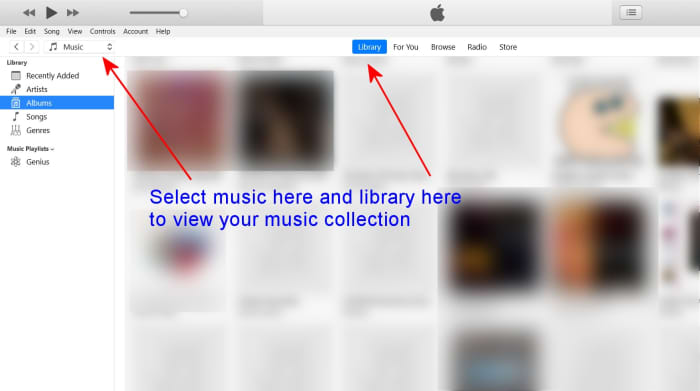How to Upload CDs to YouTube Music and Put Your Music Collection Online
How to Get Your CD Collection Online
How many audio CDs have you got? 10, 100? 1000? Wouldn't it be nice to have your entire music collection at your fingertips on your phone, tablet or notebook computer? YouTube Music allows you to do this, and the steps to uploading music from your CDs to the cloud are reasonably straightforward—the perfect project for a rainy day.
The process is simple:
- Rip the CDs using iTunes, Audio Grabber, Microsoft Media Player or similar software.
- Upload the tracks from hard drive or flash memory to the YouTube Music website.
- Once the tracks are online, they can be accessed from a desktop computer or mobile device.
I'll go over each of these processes step by step individually.
What Is "Ripping" and Is It Legal?
Ripping music from a CD refers to extracting the digital audio sound tracks from the disk and saving this music data (e.g., in the form of an MP3 file) on another CD, PC, mobile device or mobile music player.
Whether or not ripping is legal depends on the country. Copying CDs and giving the copy to a friend or giving them the copy so they can make their own is a definite illegal copyright violation. Putting music tracks on a website and sharing your collection is also illegal. Making backups for your own personal use, however, is a more fuzzy area.
In many countries, a levy is paid to content producers to compensate them for any loss due to copying. The situation is different in the UK, however. Legislation passed in October 2014 made it legal to rip CDs for backup purposes or "format shift" so you could play the MP3s on your phone or PC. Now that legislation has been overturned, and it's illegal to do so. In the US, according to the RIAA, it's ok to copy content onto an Audio CD for personal use and:
"... transferring a copy onto your computer hard drive or your portable music player, won’t usually raise concerns so long as ...The copy is made from an authorized original CD that you legitimately own ..."
How to Rip CDs
This is the first part of uploading your collection.
Step 1. Install iTunes or Other Ripping Software
There are several well known media player applications that can be used for listening to CDs, MP3 or other format audio files, podcasts, Internet radio stations, watching videos or movies and management of a music collection. ITunes is just one of these and it's very easy to use. ITunes can also rip CDs or extract the tracks off them and store those tracks as files on your computer. You can download iTunes from the Apple website here. Once tracks are imported, they end up in your iTunes library.
The iTunes Music Library Screen
This differs somewhat between versions. The first screen capture shows an older version I used to rip a CD. The reason it's older is because the laptop I used runs Windows Vista and has a CD drive. It's the last version of iTunes for that operating system. Newer desktops and laptop computers don't normally have integrated CD/DVD drives, but you can buy an external one that plugs into a USB port. The second screen capture shows what iTunes looks like on Windows 10.

Choose "Music" from the popup menu on the top left of the screen and then click "Library".
© Eugene Brennan
Step 2. Insert a CD
When you insert a CD which iTunes hasn't seen before before, it starts retrieving information about the disk from an Internet database. This information or metadata includes attributes such as the CD title, album artist, track names, track artists, genre etc. CDs are effectively "dumb" and an evolution of the vinyl record, just containing bumps or pits on a spiral track to represent stored bits of digital data.
They don't normally have any title or track info actually stored onboard in a file because originally they were designed for players that didn't have the technology to access, decode and display this type of information. Newer compact disks may possibly have metadata stored on the disk itself. Once metadata is retrieved, a list of tracks is displayed, and iTunes prompts you with a dialog as to whether it should import the CD.
Recommended

When you insert a CD that iTunes hasn't encountered before, it retrieves metadata from the Internet about the CD title, track names, etc. It also prompts you to import the CD to your computer.
© Eugene Brennan
Step 3. Before Importing, Choose Import Settings
ITunes will use default import settings for tracks that it rips from CDs and stores as files in MP3 or other format on your computer. If you want to change these settings, click "Cancel" when prompted to import and then click "Import CD" on the toolbar, which brings up the import options dialog. If you don't see this button, click on the icon on the toolbar, which looks like a CD, to bring you to the screen which displays a listing of the tracks on the disk.
File Formats
Tracks extracted from a CD can be encoded and stored on disk using several formats, but MP3 and AAC are the most useful. AAC files are the successor to MP3 and offer better sound quality at the same bit rate, but MP3 is more universally playable on a range of music devices. Both are lossy formats which means that raw uncompressed digital sound data from a CD is compressed using algorithms to make it smaller and take up less file space. In the process, data is thrown away. By choosing different bit rates and sample rates, you get a tradeoff between file size and sound quality.
On the "Import Settings" dialog that appears, choose the file format from the "Import Using" drop down menu, then pick "Custom" from the "Setting" drop down menu.
Alternatively Select "Edit" -> "Preferences" from the iTunes menu and then click the "Import Settings" button on the dialog.




